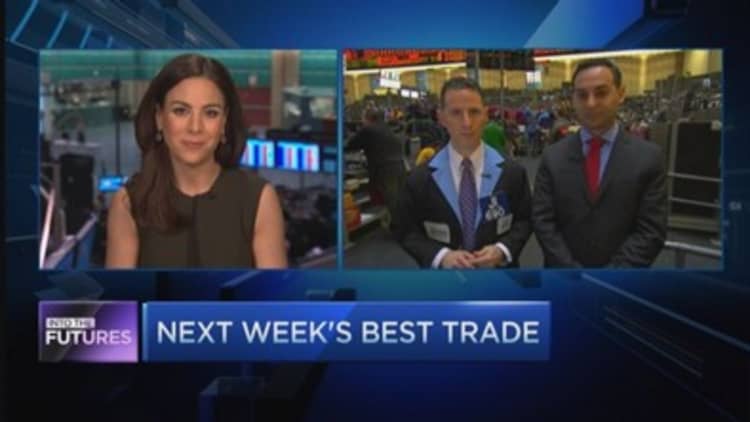
For American workers, it's about time. For corporate America, however, it may mean trouble.
After years of seeing salaries stagnate, U.S. earners are finally starting to make slightly more, with signs pointing to further wage increases to come. Yet the additional compensation could be bad news for the businesses that find themselves forced to pay up. The extra labor expense is expected to cut into profit margins, and consequently diminish returns for investors, according to some analysts.
"What's happening is that Wall Street and Main Street have switched places," Eddy Elfenbein of Crossing Wall Street wrote to CNBC. "Workers are finally getting wages while corporate profit growth has stalled. In the early stages of the recovery, it was the other way around—profits soared while jobs stagnated."
Indeed, employee compensation is finally showing signs of life.
In a much heralded boost, average hourly earnings for private workers rose to $24.75 in January, a 2.2 percent year-over-year increase. And thanks to a mix of higher wages and more people working, total compensation of employees in the fourth quarter rose 4.7 percent year over year, according to the revised U.S. growth report report released on Friday.
It's not simply that wages are tracking inflation, either. The Bureau of Labor Statistics reported on Thursday that average hourly earnings rose 2.4 percent in "real" terms from January 2014 to January 2015 (due to recently falling prices that can be pegged on lower energy costs).
Read MoreBetter fill 'er up now: Gas prices halt freefall
On Friday, investors will learn just how much wages rose in February when the latest employment report is released, alongside news on nonfarm payrolls and unemployment.
Of course, it is the big drop in unemployment that is leading to recent increases in compensation. Wage pressures are expected when the unemployment rate falls, given that a lower jobless rate indicates that the supply of labor is decreasing.
And it's not just the hard numbers pointing to compensation boosts. In a splashy move by the world's biggest retailer, Wal-Mart reported last month that it is increasing its lowest wages to $9 per hour by April, and $10 by next February. Ford and TJX Companies have also moved to increase wages.
Higher wages have to come from somewhere
But that extra money has to come from somewhere. Employment costs pose a big expense for most companies. And as their workers demand more, profit margins are liable to take a hit.
"The very tame price and wage pressures" that we've seen are set to increase, Deutsche Bank's chief U.S. economist, Joseph LaVorgna, told CNBC. "You're already seeing the impact. Margins were under tremendous pressure in Q4, and my guess is that the trend will continue for some time."
Indeed, profit growth is on the downswing of late.
companies logged profit growth of 3.7 percent in the fourth quarter, and analysts are expecting a huge earnings decline of 4.6 percent in the first quarter, according to FactSet (although estimates always drop as the results draw nigh). That compares to 8.8 percent and 2.1 percent earnings growth in the prior fourth and first quarters, respectively.
Read MoreCareful: Earnings are turning negative
"Ultimately, [wage increases] will undo the business cycle, but it's so early that it's not a threat to the business cycle quite yet, or to the bull market in stocks," said LaVorgna, who's generally bullish. "But it's something that bears watching, and it's something the Fed is certainly watching."
In fact, according to RBC Capital Market's chief U.S. market strategist, Jonathan Golub, it's only the Fed's reaction to rising watching that need be worried about—not the impact on corporate margins.
"Most people think that when the cost of labor goes up, profits go down. And if that's the only thing that changed, that would be the case," Golub said. "But in an environment in which wages are increasing, you also have more pricing power, and you're seeing increased sales volume, because the economy is doing well."
As the economy gets better, "you're selling more stuff, you're charging higher prices, and you're paying people more," he said. "But your fixed overhead costs aren't going up, so fixed cost per units starts to shrink," he explained.
Because of factors impacting the broader business ecosystem, then, wages and profit margins actually rise together, the strategist added.
Golub agrees that rising labor costs will eventually put the economy to sleep—but only because rising wages spur the Federal Reserve to enact dampening policies in order to protect against inflation.
In fact, one of the market's biggest present concerns is when the Fed will raise its target on the federal funds rate. The central bank has signaled its intention to make a move this year, as a consequence of strong employment growth.
But until monetary policy starts hampering growth, perhaps providers of labor and providers of capital—also known as workers and investors—will be able to live happily together after all.
Watch "Futures Now" Tuesdays and Thursdays at 1 p.m. ET exclusively on FuturesNow.CNBC.com!



